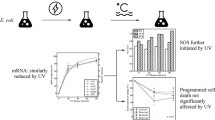Summary
The frequency of uv-induced S3-mutations (resistance to 3 γ Streptomycin/ml) in E. coli B/phr−/MC2 was not significantly increased by postincubation in NB with caffeine, though an increase is to be expected if caffeine would inhibit the dark repair of the S3-premutations. The frequency was even decreased by high (≧0,1%) caffeine concentrations (Fig. 1), which indicates an enhancement of the (caffeine-resistant) repair. This enhancement may be caused indirectly by the observed prolongation by caffeine of the lag phase which gives more time for repair. Also the strong photoprotection and (indirect) photoreversion of the S3-mutations in this (non-photoreactivable) strain were not influenced by caffeine-posttreatment (Fig. 2 and 3). Thus, the dark repair assumed to be stimulated by pre- or post-illumination would be of the caffeine-resistant type. The repair of S3-premutations occurring during post-treatment in saline was inhibited by caffeine (Fig. 4). Also the dark-reactivation of cells killed by uv was inhibited by caffeine in the NB-agarmedium (Fig. 5). It is assumed that the repair of S3-premutations going on in NB-suspended cells is due to a mechanism which is not or only weakly inhibitable by caffeine and which is different from the caffeine-sensitive mechanism working under hunger conditions (perhaps by excising uv-products). Since reactivation of killed cells is caffeine-sensitive but reversion of S3-premutations is caffeine-resistant in NB-cells the uv-induced lethal lesions must be different from the S3-premutations.
Similar content being viewed by others
Literatur
Doneson, I. N., and D. M. Shankel: Mutational synergism between radiations and methylated purines in E. coli. J. Bact. 87, 61–67 (1964).
Goes, E., u. R. W. Kaplan: Der Einfluß der Nachbehandlung mit verschiedenen Substanzen auf die UV-induzierte Rate der Farbmutationen von Serratia marcescens CV. Z. allg. Mikrobiol. 4, 267–289 (1962).
Harm, W., and B. Hillebrandt: A non-photoreactivable mutant of E. coli B. Photochem. Photobiol. 1, 271–272 (1962).
Heil, K.: UV-Inaktivierung und Mutationsauslösung beim Phagen ϰ und dessen Wirts-Bakterien mit normaler und verminderter Photoreaktivierung. Diss. Nat. Fak. Universität Frankfurt a.M. 1966.
Kaplan, R. W.: Neuere Entwicklungen in der Mikrobengenetik. Zbl. Bakt., I. Abt. Orig. 160, 181–193 (1953).
— Photoreversion von vier Gruppen UV-induzierter Mutationen zur Giftresistenz im nichtphotoreaktivierbaren E. coli. Photochem. Photobiol. 2, 461–470 (1963).
— u. W. Gunkel: Reversion der Mutationen und Reaktivierung durch sichtbares Licht sowie verschiedene Salzlösungen nach UV-Bestrahlung von Serratia. Arch. Mikrobiol. 35, 63–91 (1960)
— u. G. Witt: Photoreversion und Photoprotektion bei UV-induzierten Mutationen des nichtphotoreaktivierbaren Bacteriums E. coli phr−. Z. Vererbungsl. 97, 209–217 (1965).
Kondo, S., and T. Kato: Action spectra for photoreactivation of killing and mutation to prototrophy in UV-sensitive strains of Escherichia coli possessing and lacking photoreactivating enzyme. Photochem. Photobiol. 5, 827–837 (1966).
Lieb, M.: Enhancement of ultraviolet-induced mutations in bacteria by caffeine. Z. Vererbungsl. 92, 416–429 (1961).
Metzger, K.: On the darkreactivation mechanism in ultraviolet irradiated bacteria. Biochem. biophys. Res. Commun. 15, 101–109 (1964).
Rupert, C. S.: Relation of photoreactivation to photoenzymatic repair of DNA in Escherichia coli. Photochem. Photobiol. 4, 271–275 (1965).
Shankel, D. M.: Effects of metabolite analogues on development of mutations induced by “noncidal” amounts of ultraviolet light. Bact. Proc. 99 (1961).
— “Mutational synergism” of ultraviolet light and caffeine in Escherichia coli. J. Bact. 84, 410–415 (1962).
Winkler, U.: Host-cell reactivation of lethal damage induced by ultraviolet light and x-rays in Serratia marcescens HY and its phage ϰ. Virology 24, 518–520 (1964).
Witkin, E. M.: Time, temperature and protein synthesis: A study of ultraviolet-induced mutations in bacteria. Cold Spr. Harb. Symp. quant. Biol. 21, 123–140 (1956).
Witkin, E. M.: Post-irradiation metabolism and the timing of ultraviolet-induced mutations in bacteria. Proc. X Intern. Congr. Genetics, August 20–27, 1958, McGill Univ., Montreal, Canada, Acad. Press, 1, 280–299 (1959).
— Radiation-induced mutations and their repair. Science 152, 1345–1353 (1966a).
— Mutation and the repair of radiation damage in bacteria. Radiat. Res., Suppl. 6, 30–53 (1966b).
Author information
Authors and Affiliations
Rights and permissions
About this article
Cite this article
Horneck-Witt, G., Kaplan, R.W. Einfluß von Coffein auf die Reparatur von UV-Prämutationen bei der phr−-Mutante von E. coli . Molec. Gen. Genetics 101, 123–130 (1968). https://doi.org/10.1007/BF00336578
Received:
Issue Date:
DOI: https://doi.org/10.1007/BF00336578




